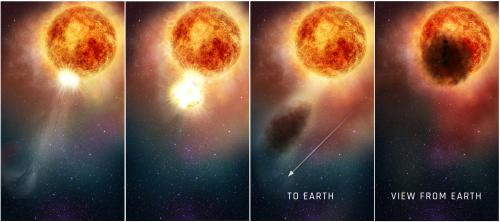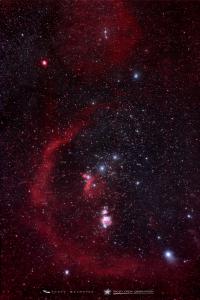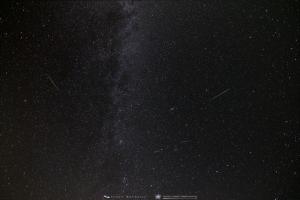Celebration of Space - August 14, 2020

An artists impression of a dense dust cloud over Betelgeuse southern hemisphere. Credit: NASA, ESA, and E. Wheatley (STScI)
This past autumn and early winter (2019), we noticed a significant dimming of the bright red supergiant star, Betelgeuse in the constellation Orion. Being that Betelgeuse is the leading known supernova candidate in the Milky Way Galaxy, this had everybody freaking out. After a bout of data collection and research, led by Andrea Dupree of the Harvard Center for Astrophysics (CfA) using the Hubble Space Telescope (HST), we learned that the dimming was the likely result of a fabulous ejection of plasma that cooled into a dust cloud along the line of site from Earth. Which blocked a large portion of the starlight emitted by Betelgeuse towards Earth. Let’s talk about Betelgeuse for a moment.
Betelgeuse, also known as Alpha Orion, is a red supergiant star. It is found in the constellation Orion, posing as Orion’s right shoulder. You have probably noticed it as the star that is notably redder than all other visible stars in the constellation Orion. Now Betelgeuse is a semi-regular variable star, which means that its visible magnitude (brightness) changes on a cycle of about 400 days. Though the amount of dimming and brightening is not consistent and will vary depending on any given cycle. What makes Betelgeuse so interesting is that it’s considered a high-mass star, part of a population that makes up only 3% of all stars in the Milky Way Galaxy. With about 12 times the mass of the Sun, Betelgeuse is a supernova candidate. Since Betelgeuse resides at an approximated distance of 700 light years, which is quite close to us, the light we see is 700 years old. The result is that Betelgeuse is likely the closest supernova candidate that we may see in our lifetime, and a fabulous supernova it would be! This is why unexpected changes in this star are always so high profile.
During the months of September - November 2019, Dr. Dupree and her team made several ultraviolet (UV) spectroscopic observations of Betelgeuse. What they discovered was a rather intense increase of superheated stellar material moving from the star’s surface into and through the star’s atmosphere. Once expelled, this super-heated material cooled quickly and formed a dense dust cloud spanning millions of miles out from the star. This dust cloud then obscured our view of the southern region of Betelgeuse, causing the dimming we observed. At this time, we are unsure of what caused this large outburst of plasma from Betelgeuse, though it doesn’t really indicate an immanent supernova.
Regardless, Betelgeuse is a fascinating star, and a staple in the constellation Orion. If we do get to observe Betelgeuse going supernova, the view will be visible without a telescope and during the day time, being about as bright as the full Moon is during the daytime. So keep your eyes on Betelgeuse, which is a wintertime star in the Northern Hemisphere, and perhaps you just may catch a supernova!
This past week, the Perseid Meteor Shower peak occurred. Though not the best year for peak viewing, due to the presence of the waning crescent Moon during the morning hours, which is the best time to observe, we did expect an okay showing. As usual, some weather anomaly occurred, blocking our view of the shower. Sadly, it’s been 5 years now since we have observed the Perseid Meteor Shower peak at Frosty Drew, all due to weather anomalies. It was suggested by a Frosty Drew Astronomer (Sean Perkins) in 2018 that the reason we have had such bad showings of the Perseid shower was due to wildfire season in the western USA and Canada. This suggestion got us researching smoke density along the jet stream and other weather fronts. We realized that the localized amount of smoke, originating from wildfires on other parts of the continent, certainly played a role in weather anomalies that negatively impacted viewings of the Perseid Meteor Shower over Southern New England, and alternatively brought those fantastic red Moon rises, and red sunsets. In 2020 we saw a lower than average number of wildfires, which made us quite excited about Perseid prospects. Though fog stepped right up to the challenge. Regardless, the Perseid shower is known to put on a good post-peak showing for about one week. At Frosty Drew we have repeatedly observed better meteor rates on the night after the peak night. This year, we had fog straight through. Perhaps tonight will make up the difference. In any case, it’s worth a night out looking at the stars!
-Scott
- Author:
- Scott MacNeill
- Entry Date:
- Aug 14, 2020
- Published Under:
- Scott MacNeill's Columns



